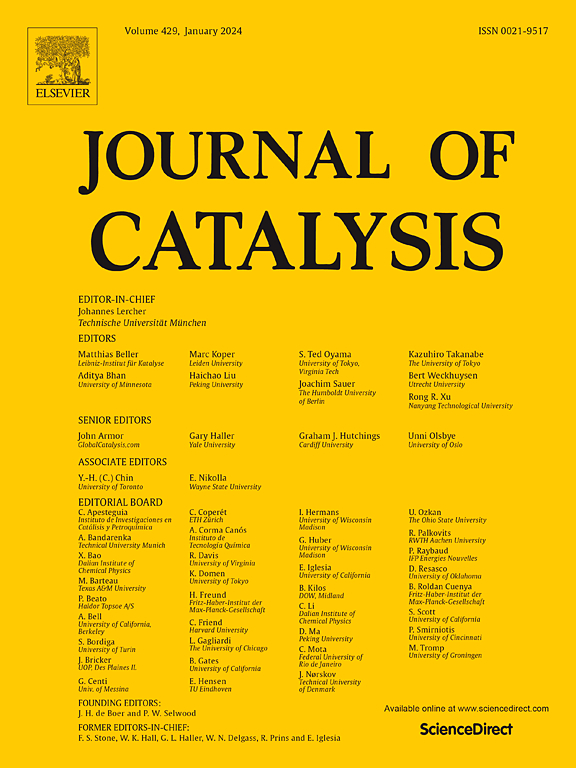Unveiling high-performance single-atom alloy catalysts for alkane dehydrogenation through DFT and machine learning synergy
IF 6.5
1区 化学
Q2 CHEMISTRY, PHYSICAL
引用次数: 0
Abstract
The recent surge in shale gas production has renewed interest in efficient alkane dehydrogenation for the synthesis of fuels and high-value chemicals. However, developing cost-effective catalysts that exhibit high catalytic activity while minimizing over-dehydrogenation and carbon deposition remains a significant challenge. Here, we integrate density functional theory (DFT) calculations with machine learning (ML) to design single-atom alloy (SAA) catalysts for efficient alkane dehydrogenation. Using DFT, we calculate 92 C![]() H bond disassociation energy barriers to construct a dataset, which is used to train eight ML algorithms with 12 features. The top-performing Bagging Regression (BAR) model is then employed to predict C
H bond disassociation energy barriers to construct a dataset, which is used to train eight ML algorithms with 12 features. The top-performing Bagging Regression (BAR) model is then employed to predict C![]() H bond activation energy barriers on the surfaces of 53 SAA candidates, enabling rapid screening of methane dehydrogenation activity. Among these, the Ru1Cu SAA catalyst exhibits outstanding activity, outperforming pure Pt. Detailed DFT calculations confirm that Ru1Cu(111) not only exhibits superior performance in methane dehydrogenation, but also exceptional activity in the dehydrogenation of propane, ethane, and isobutane. Moreover, microkinetic simulations further confirm the high selectivity of the Ru1Cu(111) surface toward propylene during propane dehydrogenation. Feature engineering analyses reveal the critical roles of dehydrogenation steps and the surface energy of the single-atom metal in influencing C
H bond activation energy barriers on the surfaces of 53 SAA candidates, enabling rapid screening of methane dehydrogenation activity. Among these, the Ru1Cu SAA catalyst exhibits outstanding activity, outperforming pure Pt. Detailed DFT calculations confirm that Ru1Cu(111) not only exhibits superior performance in methane dehydrogenation, but also exceptional activity in the dehydrogenation of propane, ethane, and isobutane. Moreover, microkinetic simulations further confirm the high selectivity of the Ru1Cu(111) surface toward propylene during propane dehydrogenation. Feature engineering analyses reveal the critical roles of dehydrogenation steps and the surface energy of the single-atom metal in influencing C![]() H bond activation. These findings underscore the effectiveness of the DFT–ML framework for catalyst discovery and highlight Ru1Cu SAA as a highly active, selective, and stable catalyst with strong resistance to over-dehydrogenation and carbon deposition, making it a highly promising candidate for alkane dehydrogenation.
H bond activation. These findings underscore the effectiveness of the DFT–ML framework for catalyst discovery and highlight Ru1Cu SAA as a highly active, selective, and stable catalyst with strong resistance to over-dehydrogenation and carbon deposition, making it a highly promising candidate for alkane dehydrogenation.


通过DFT和机器学习协同作用揭示烷烃脱氢的高性能单原子合金催化剂
最近页岩气产量的激增重新引起了人们对用于合成燃料和高价值化学品的高效烷烃脱氢的兴趣。然而,开发具有高催化活性的低成本催化剂,同时最大限度地减少过度脱氢和碳沉积,仍然是一个重大挑战。在这里,我们将密度泛函理论(DFT)计算与机器学习(ML)相结合,设计了用于高效烷烃脱氢的单原子合金(SAA)催化剂。利用DFT计算了92个CH键解离能垒,构建了一个数据集,该数据集用于训练具有12个特征的8种ML算法。然后使用性能最好的Bagging Regression (BAR)模型预测53种SAA候选材料表面的CH键活化能垒,从而快速筛选甲烷脱氢活性。其中,Ru1Cu SAA催化剂表现出优异的活性,优于纯Pt。详细的DFT计算证实,Ru1Cu(111)不仅在甲烷脱氢中表现出优异的性能,而且在丙烷、乙烷和异丁烷的脱氢中也表现出优异的活性。此外,微动力学模拟进一步证实了丙烷脱氢过程中Ru1Cu(111)表面对丙烯的高选择性。特征工程分析揭示了脱氢步骤和单原子金属的表面能在影响CH键活化中的关键作用。这些发现强调了DFT-ML框架在催化剂发现方面的有效性,并突出了Ru1Cu SAA作为一种高活性、选择性和稳定性的催化剂,具有很强的抗过脱氢和碳沉积能力,使其成为烷烃脱氢的极有前景的候选催化剂。
本文章由计算机程序翻译,如有差异,请以英文原文为准。
求助全文
约1分钟内获得全文
求助全文
来源期刊

Journal of Catalysis
工程技术-工程:化工
CiteScore
12.30
自引率
5.50%
发文量
447
审稿时长
31 days
期刊介绍:
The Journal of Catalysis publishes scholarly articles on both heterogeneous and homogeneous catalysis, covering a wide range of chemical transformations. These include various types of catalysis, such as those mediated by photons, plasmons, and electrons. The focus of the studies is to understand the relationship between catalytic function and the underlying chemical properties of surfaces and metal complexes.
The articles in the journal offer innovative concepts and explore the synthesis and kinetics of inorganic solids and homogeneous complexes. Furthermore, they discuss spectroscopic techniques for characterizing catalysts, investigate the interaction of probes and reacting species with catalysts, and employ theoretical methods.
The research presented in the journal should have direct relevance to the field of catalytic processes, addressing either fundamental aspects or applications of catalysis.
 求助内容:
求助内容: 应助结果提醒方式:
应助结果提醒方式:


